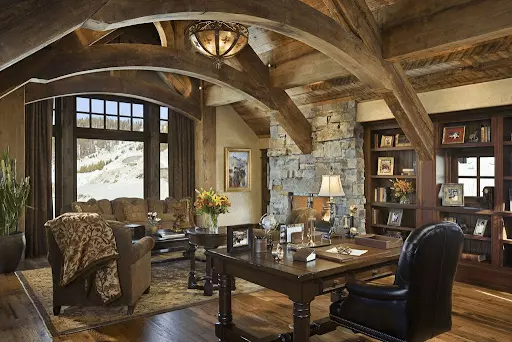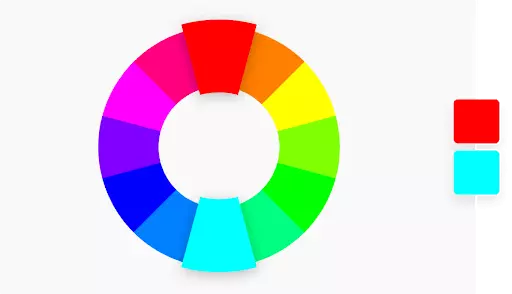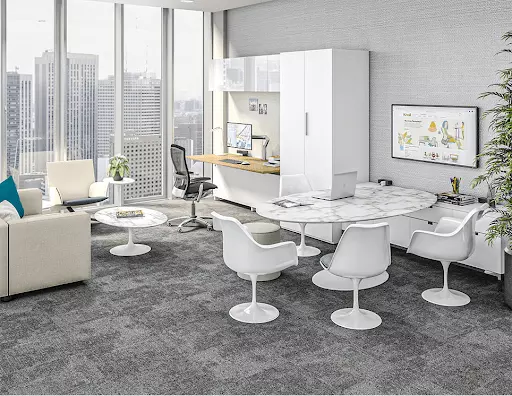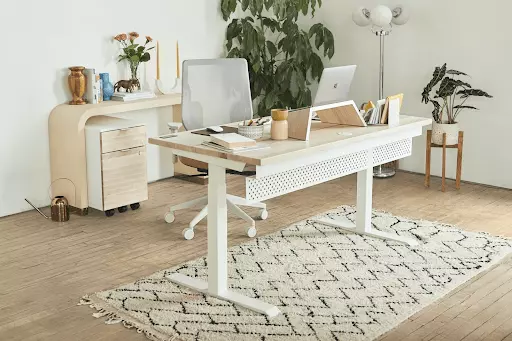Think about your office space. Is it dark, dull, and cluttered? Or warm, inspiring, and comfortable? Your office design significantly impacts your well-being, creativity, productivity, and job satisfaction more than you think! In this article, we'll explore the benefits of well-designed office spaces and provide you with 65 tips and ideas to reimagine yours.
The Benefits of a Well-Designed Office Space
Whether you work from home, in a corporate office, or in a cubicle, a well-designed workspace sets the stage for doing your best work. It's not just about appearances; it's about improving functionality too. When you consider the various factors that contribute to a good design, your creativity goes up along with your job satisfaction.
For example:
- Colors: The psychology of color indicates that colors influence your mood. For example, blue can help you feel calm and secure.
- Nature: Exposure to nature and plants increases productivity by 15%.
- Organization: Being organized reduces stress, depression, and procrastination.
- Comfort: Motivation and morale go up when you feel comfortable.
Let's delve into office decor ideas for various scenarios, including small, home, professional, and corporate offices. We'll also consider important factors such as visuals, spacing, layout, colors, acoustics, smells, and ergonomics. So, no matter what kind of office you have, you can find design ideas suited to your needs.
Home office
For your home office, you have much more DIY and personalization flexibility. Embrace this opportunity to create a space that reflects your personality and boosts your productivity.
Corporate office
In a corporate office, you may need to consult with HR or an interior designer to determine what's possible in terms of design. However, there are still plenty of ways to add a personal touch to your workspace.
Small office
In a small office, smart storage and creative functionality are key. Think about how to maximize the use of space without compromising on style.
Cubicle
Although cubicles can be limiting, you can still inject your personality into your workspace. Consider adding small pieces of art, accents, and accessories to make it feel more personalized.
Law office
Serious settings like law offices may require less personalization, but you can still incorporate elements that inspire you and create a conducive work environment.
Executive office
Executive offices should focus on functionality for various meetings you might hold. Consider how the layout and decor can enhance your workflow and make a strong impression on clients.
65 Office Decor Ideas & Tips
#1 Choose your design theme
Choosing a theme for your office decor is an excellent way to focus your creative decisions. Select a theme that resonates with your personality and the context of the space. Some themes to consider include modern, traditional, art deco, industrial, contemporary, nautical, retro, Scandinavian, and farmhouse or rustic.
 Image credit
Image credit
One great way to start choosing your office design theme is by putting the various ideas listed above into a Pinterest search and pinning the styles that resonate with you.
#2 Choose your color palette
Not everyone is a genius with color combinations, but that's okay. There are color palette generators that can make figuring out your color scheme easier.
For your office design, choose one or two main colors that make up 60% of the space, a secondary color that makes up 30% of the space, and an accent color that makes up 10% of the space for a cohesive scheme. Consider classic color palettes such as monochromatic, analogous, triad, and complementary.
 Image credit
Image credit
If you're unfamiliar with color wheels, Canva has a great color wheel tool you can use to figure out which colors go well together.
Pro Tip: Did you know? Colors can affect your behavior! For example, blue can give you a sense of calmness and stability. Check out our article on color psychology to learn more.
#3 Determine a budget that works for you
Determining your budget may not be the most exciting part of designing your office, but it's an important step. It can help you make smart decisions and open up possibilities for DIY projects or shopping at second-hand stores.
Consider the following expenses when creating your budget:
- Remodeling: Flooring, walls, labor, etc.
- Furniture: Desk, chair, bookshelves, additional seating, tables, etc.
- Lighting: Built-in lights, lamps, studio lights, etc.
- Wall and window treatments: Paint, wallpaper, curtains, etc.
- Shelving and storage: Built-ins, bookshelves, etc.
- Accessories: Photos, plants, knick-knacks, supplies, rugs, etc.
- Art: Posters, display pieces, paintings, etc.
#4 Don't underestimate your DIY capabilities
Looking at a budget can be discouraging, but don't underestimate what you can build and design yourself! DIY projects can be fun and a great way to personalize your space. Here are some office decor ideas you can DIY:
- Create a desk with a wood plank and two cabinets.
- Paint a wall with chalkboard paint to use as a brainstorming space.
- Customize items using websites like Zazzle, where you can add your own designs to various office decor items.
#5 Think about how you function
Consider your daily routine and habits in your office. Do you spend a lot of time on Zoom calls? Do you start your day with coffee and catching up on the news? Do you need ample space for spreading out projects? Take note of what's working and what can be improved to determine an ideal layout.
#6 Plan your layout
Planning your layout can be as simple as sketching it on paper or using free interior design programs like Room Sketcher to visualize your space virtually.
 Image credit
Image credit
If you choose to sketch on paper:
- Draw the walls of your space on paper.
- Cut out furniture pieces you want to incorporate.
- Place the cut-out furniture pieces in different variations.
- Imagine yourself in the space with different layouts and choose the one that works best for you. Remember, you can always change your mind later if it doesn't feel right!
#7 Create office zones
Creating zones for different activities is a helpful layout trick. Even in small spaces, you can get creative and designate specific areas for different activities. Plan your zones by first figuring out what you plan to do in your office. Then, determine the most suitable location for each activity. For example:
- In-person meetings: Set up a space with chairs, a small couch, and a table.
- Zoom calls: Create a space with good lighting and a non-distracting background.
- Podcast recordings: Use an area divided by sound-absorbing materials.
- Breaks: Designate an area for relaxation, inspiration, or coffee/snacks.
- Printing: Set aside a tucked-away space for printing.
- Reading/Research: Create a separate space away from your desk.
- Writing: Optimize your desk area for quiet, focused work.
- Brainstorming: Utilize a larger workspace with inspiration and a whiteboard or chalkboard.
- Group projects: Designate a space with a worktable at the center.
Remember, some zones can be dual-purpose, especially in smaller spaces. This exercise will help you see your office in different ways and increase your joy and productivity.
 Image credit
Image credit
Pro Tip: Don't underestimate the space in the center of the room. Instead of placing all furniture against the walls, consider putting your desk in the middle of the room for a change.
#8 Add warmth and zoning with rugs
If you have a larger office space, one simple trick to separate different zones is to add rugs. Rugs not only help define specific areas for different activities but also add warmth and character to a room.
Bonus Tip: You can also create privacy and divide zones with wall partitions (see tip #13 on creating privacy).
#9 Show personality with unique flooring
Don't limit your office design to just the walls and decor. If you have the flexibility to change up the flooring, it can be an excellent opportunity to showcase your personality.
- Hardwood or cement floors: Add a touch of color with paint or rugs.
- Carpet: Add warmth and reduce noise for recordings or frequent video calls. Ensure the carpet is compatible with your desk chair if you plan on rolling around.
- Laminate flooring: Explore unique flooring options without breaking the bank.
#10 Let your desk position command the room
Placing your desk in a position that faces the center of the room can create an open and empowering work environment. It allows you to have a commanding view of the room and sends a message of openness to collaboration. Additionally, facing away from the office entry prevents unexpected surprises.
 Image credit
Image credit
#11 Create a cozy collaborative space
Even if you primarily work alone from home, having a cozy, collaborative space in your office can make it feel more inviting. It provides a spot for occasional conversations with roommates or partners. Add cozy seating with pillows and throws, and include a coffee table for a relaxed atmosphere.
Bonus Tip: This space can double as a break area for you to sip coffee and enjoy a good book.
 Image credit
Image credit
#12 Include privacy features
If your office is used for various types of meetings, you may want to add privacy features that make you feel less exposed. Decorative wall partitions are a simple solution that provides privacy, especially in home offices where you want to separate your workspace from your living area.
 Image credit
Image credit
Pro Tip: Your dividers can serve multiple purposes! Consider using a double-sided whiteboard or chalkboard/corkboard as a room divider.
#13 Add a fun break space
Creating a designated space for breaks can be a great motivation booster throughout the day. Whether it's a foosball table, ping pong table, reading nook, crafting corner, or music station, find an activity that brings you joy and include it in your office design.
 Image credit
Image credit
#14 Don't forget about project space
While your desk is ideal for focused computer work, there will be times when you need to spread out and examine multiple items simultaneously. Therefore, having ample project space is essential. If you're short on space, consider multifunctional furniture and storage options (see tips #16 and #31).

















